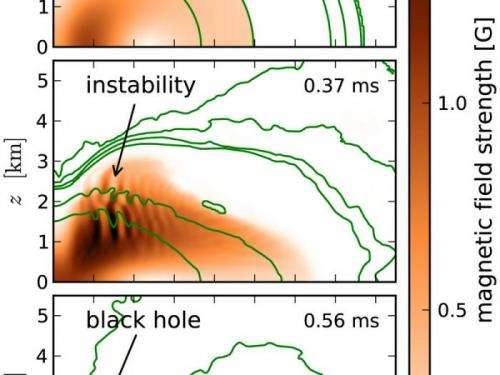The largest magnetic fields in the universe

An ultradense ("hypermassive") neutron star is formed when two neutron stars in a binary system finally merge. Its short life ends with the catastrophic collapse to a black hole, possibly powering a short gamma-ray burst, one of the brightest explosions observed in the universe.
Short gamma-ray bursts as observed with satellites like XMM Newton, Fermi or Swift release within a second the same amount of energy as our galaxy in one year. It has been speculated for a long time that enormous magnetic field strengths, possibly higher than what has been observed in any known astrophysical system, are a key ingredient in explaining such emission. Scientists at the Max Planck Institute for Gravitational Physics (Albert Einstein Institute/AEI) have now succeeded in simulating a mechanism which could produce such strong magnetic fields prior to the collapse to a black hole.
How can such ultrahigh magnetic fields—stronger than ten or hundred million billion times the Earth's magnetic field—be generated from the much lower initial neutron star magnetic fields?
This could be explained by a phenomenon that can be triggered in a differentially rotating plasma in the presence of magnetic fields: neighboring plasma layers, which rotate at different speeds, "rub against each other," eventually setting the plasma into turbulent motion. In this process called magnetorotational instability magnetic fields can be strongly amplified. This mechanism is known to play an important role in many astrophysical systems such as accretion disks and core-collapse supernovae. It had been speculated for a long time that magnetohydrodynamic instabilities in the interior of hypermassive neutron stars could bring about the necessary magnetic field amplification. The actual demonstration that this is possible has only now been achieved with the present numerical simulations.
The scientists of the Gravitational Wave Modeling Group at the AEI simulated a hypermassive neutron star with an initially ordered ("poloidal") magnetic field, whose structure is subsequently made more complex by the star's rotation. Since the star is dynamically unstable, it eventually collapses to a black hole surrounded by a cloud of matter, until the latter is swallowed by the black hole.
These simulations have unambiguously shown the presence of an exponentially rapid amplification mechanism in the stellar interior—the magnetorotational instability. This mechanism has so far remained essentially unexplored under the extreme conditions of ultrastrong gravity as found in the interior of hypermassive neutron stars. This is because the physical conditions in the interior of these stars are extremely challenging.
The discovery is interesting for at least two reasons. First, it shows for the first time unambiguously the development of the magnetorotational instability in the framework of Einstein's general theory of relativity, in which there exist no analytical criteria to date to predict the instability. Second, this discovery can have a profound astrophysical impact, supporting the idea that ultrastrong magnetic fields can be the key ingredient in explaining the huge amount of energy released by short gamma-ray bursts.
More information: Siegel, D. M., Ciolfi, R., Harte, A. I., Rezzolla, L., "Magnetorotational instability in relativistic hypermassive neutron stars," Physical Review D, 87, 121302(R), 2013. prd.aps.org/abstract/PRD/v87/i12/e121302
Journal information: Physical Review D
Provided by Max Planck Society











.jpg)








